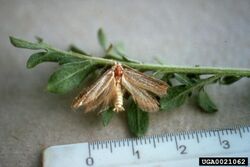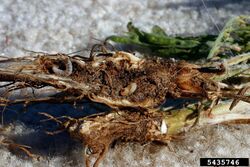Biology:Pterolonche
| Pterolonche | |
|---|---|

| |
| Pterolonche inspersa adult | |
| Scientific classification | |
| Domain: | Eukaryota |
| Kingdom: | Animalia |
| Phylum: | Arthropoda |
| Class: | Insecta |
| Order: | Lepidoptera |
| Family: | Pterolonchidae |
| Genus: | Pterolonche Zeller, 1847 |
| Synonyms | |
| |
Pterolonche is small genus of small moths of the family Pterolonchidae.[1][2]
Taxonomy
The genus was first circumscribed in 1847 by Philipp Christoph Zeller to include two new species.[1][2] The type species is Pterolonche albescens.[2]
In 1984 Antonio Vives Moreno described the new species P. gozmaniella from Andalucia, but in 1987 Vives reviewed the family Pterolonchidae in Spain, synonymising P. gozmaniella with P. lutescentella and P. gracilis with P. inspersa, describing a new species, and counting five species in the genus Pterolonche. He subdivided the genus in three subgenera. He did not address the species described by Hans Georg Amsel from respectively Malta and Iraq a few decades earlier.[1]
In 2011 it was classified as one of two genera in the family Pterolonchidae in the superfamily Gelechioidea by van Nieukerken et al.[3]
In 2014 a cladistics analysis performed by Heikkilä et al. expanded the family to seven genera. They classified the genus in the subfamily Pterolonchinae.[4]
Species
The following species are known:[1][2]
- subgenus Pterolonche - The imagoes have a white or greyish general colouration
- Pterolonche albescens Zeller, 1847 - Sicily, throughout Spain , Balearic Islands, Islas de Cabreras, Algarve, France , Hungary, Romania, the former Yugoslavia, Turkey, Malta, Morocco
- Pterolonche inspersa Staudinger, 1859 - Portugal, Spain, France, Italy, Sardinia, Sicily, the Czech Republic, Slovakia, Hungary, Bulgaria, Greece, Crete, Turkey, Egypt and Morocco.[5]
- Pterolonche vallettae Amsel, 1955 - Malta[6]
- subgenus Agenjius Vives, 1987 - The imagoes have a pinkish-yellow colouration
- Pterolonche lutescentella Chrétien, 1922 - Andalucia, Balearic Islands and northwest Magreb in Morocco, Algeria, Tunisia
- subgenus Gomezbustillus Vives, 1987 - The imagoes have a pallid yellow colouration
- unplaced
- Pterolonche kurdistanella Amsel, 1959 - Iraq
Distribution
The species are all found around the Mediterranean Sea.[2] Spain has at least five species, Portugal has four.[1] As far as is known, P. vallettae appears to be endemic to Malta.[6]
Ecology
The species are all nocturnal. Both sexes are attracted to artificial lights at night. In Spain the moths have two generations per year, with the first emerging from the end of march to the beginning of June, and a second, much more abundant generation between July and the start of October. They have been encountered from sea level to 1500m in altitude in Spain.[1]
P. inspersa caterpillars feed on Centaurea species, a herbaceous, thistle-like plant. They tunnel into the root crown of their host plant and feed on the root tissue. As they reach the root cortex, they spin a silken tube and feed from within the tube. Mature larvae overwinter in the roots. In spring, a silken tube is made above the soil surface in which pupation takes place.[7]
Uses
P. inspersa was released as a biological control agent for knapweed, Centaurea diffusa, in Colorado, Montana, and Oregon in the mid to late 1980s, although there was no known establishment of the species in the United States initially, it has since spread to Idaho and British Columbia.[7][8]
References
- ↑ 1.0 1.1 1.2 1.3 1.4 1.5 Cite error: Invalid
<ref>tag; no text was provided for refs namedVives1987 - ↑ 2.0 2.1 2.2 2.3 2.4 Savela, Markku (24 August 2017). "Pterolonche". http://www.nic.funet.fi/index/Tree_of_life/insecta/lepidoptera/ditrysia/gelechioidea/pterolonchidae/pterolonchinae/pterolonche/.
- ↑ van Nieukerken, Erik J.; Kaila, Lauri; Kitching, Ian J.; Kristensen, Niels P.; Lees, David C.; Minet, Joël; Mitter, Charles; Mutanen, Marko et al. (2011). "Order Lepidoptera Linnaeus, 1758". in Zhang, Zhi-Qiang. Animal biodiversity: an outline of higher-level classification and survey of taxonomic richness. pp. 212–221. ISBN 978-1-86977-850-7. https://www.mapress.com/zootaxa/2011/f/zt03148p221.pdf. Retrieved 26 December 2019.
- ↑ Heikkilä, Maria; Mutanen, Marko; Kekkonen, Mari; Kaila, Lauri (November 2014). "Morphology reinforces proposed molecular phylogenetic affinities: a revised classification for Gelechioidea (Lepidoptera)". Cladistics 30 (6): 563–589. doi:10.1111/cla.12064. PMID 34794251. https://www.researchgate.net/publication/258687778. Retrieved 17 December 2019.
- ↑ "Pterolonche inspersa Staudinger, 1859". Fauna Europaea Secretariat, Museum für Naturkunde Leibniz & Institut für Evolutions- und Biodiversitätsforschung. http://www.faunaeur.org/full_results.php?id=436401.
- ↑ 6.0 6.1 "Pterolonche Zeller, 1847". Fauna Europaea Secretariat, Museum für Naturkunde Leibniz & Institut für Evolutions- und Biodiversitätsforschung. http://www.faunaeur.org/full_results.php?id=436401.
- ↑ 7.0 7.1 "Pterolonche inspersa". Center for Invasive Species and Ecosystem Health, University of Georgia. 19 January 2011. http://wiki.bugwood.org/Archive:Knapweed/Pterolonche_inspersa.
- ↑ "Pterolonche inspersa". Department of Entomology, Cornell University. http://www.biocontrol.entomology.cornell.edu/weedfeed/pterolonche.html.
Wikidata ☰ Q10355356 entry
 |



